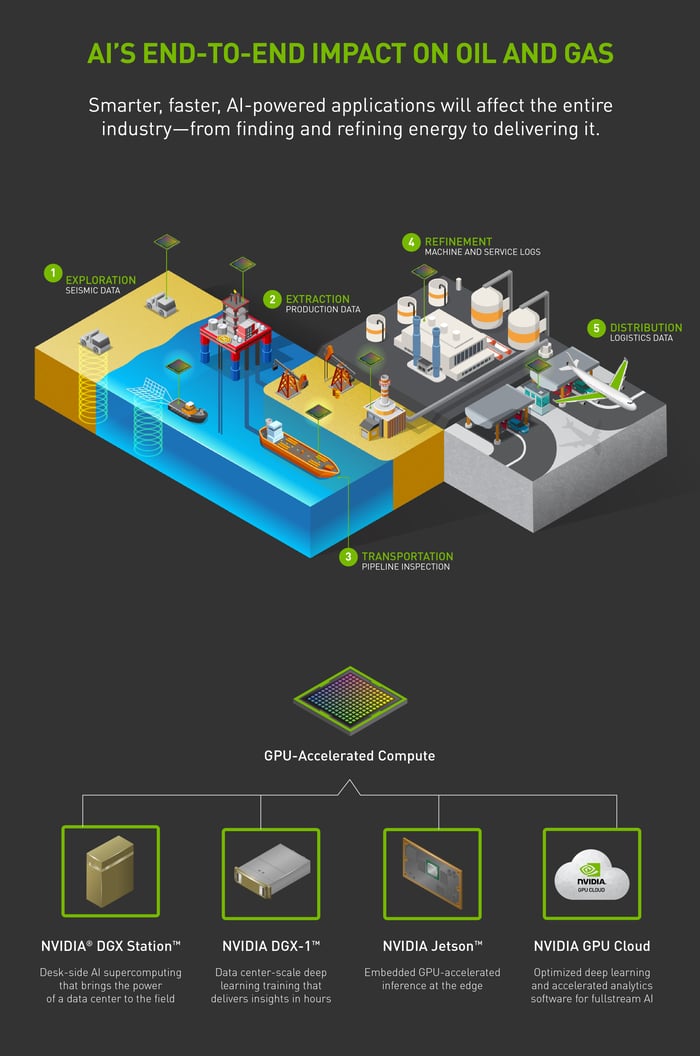NVIDIA's (NVDA 1.88%) graphics processing unit (GPU)-based approach to high-performance computing and deep learning, a category of artificial intelligence (AI) in which machines are trained to make inferences from data the way humans do, has begun making inroads into the global oil and gas industry.
This is great news for investors, as this is a multitrillion-dollar industry that forms the foundation of the global economy. While renewable forms of energy have been steadily displacing fossil fuels to generate electricity and electric vehicles (EVs) have begun lessening the transportation industry's ravenous appetite for petroleum products, full transformations of these realms will take decades. Moreover, beyond being used to produce just about everything, oil derivatives are key ingredients in products ranging from plastics and fertilizers to the asphalt that paves our roads and the synthetic fibers that clothe many of us.
In 2018, NVIDIA has announced two wins in the oil and gas space. Here's what you should know.

Image source: Getty Images.
Partnership with Baker Hughes is moving "full-stream" ahead
In late January, NVIDIA and Baker Hughes, a GE Company (BKR -1.16%) announced a partnership that involves the full-stream oil and gas company using NVIDIA's GPU-based approach to artificial intelligence and high-performance computing (HPC) to help oil and gas companies process and analyze oceans of data to provide insights that will assist them in improving their productivity and reducing their costs of finding, extracting, processing, and transporting oil. ("BHGE" was formed by last summer's merger of General Electric's (GE 1.62%) oil and gas business with Baker Hughes, a well-established oil-field services company.)
BHGE provides equipment, services, and digital solutions across the oil and gas industry's entire range of operations. It will be using all of NVIDIA's AI solutions, including its DGX-1 AI supercomputer for training deep-learning models in data centers; its DGX Stations for AI supercomputing at the desk side or on remote offshore drilling platforms, where bandwidth limitations prevent connectivity to a data center; and its Jetson AI supercomputers-on-a-module for real-time, continuous deep-learning inferencing "at the edge," or right at the spot the data is collected. (Inferencing involves machines using their deep-learning training to make inferences from new data.) It's pretty safe to assume that Jetson will be incorporated into drones for pipeline inspections, and perhaps other uses.

Image source: Baker Hughes via NVIDIA.
Examples of how an oil company could use NVIDIA's GPU-accelerated AI solutions include to "predict failures and identify rock formations, as well as to mine 3D models to create efficient environment scans, which can aid procurement of drilling permits," according to NVIDIA. This stat shows how much potential NVIDIA's AI and HPC solutions have in the oil and gas industry: The average offshore drilling rig generates 50 terabytes of data annually, through sensors and operational and financial sources, but less than 1% of that data is tagged or analyzed, according to BHGE.
Helping Italy's Eni accelerate its gas and oil exploration process
In late February, NVIDIA announced that Italian oil and gas giant Eni, which is considered one of the industry's global supermajors, quadrupled the computing capacity of its Green Data Center just outside Milan by adding its HPC4 supercomputer. The launch of HPC4, supplied by HP Enterprises and packed with 3,200 NVIDIA Tesla GPU accelerators, makes Eni's HPC infrastructure "the world's most powerful industrial computing system today," according to NVIDIA.

The Zohr natural gas project located in the Egyptian territorial waters of the Mediterranean Sea. Image source: Eni.
Eni -- which operates in the upstream through downstream spaces of the industry and has operations in more than 70 countries -- aims to use its massive computing power to accelerate its oil and gas exploration phase and better manage the sea of data its operations generate. The company is an early mover in its industry in using high-performance computing, and in 2014 it won an award from the HPC community's leading publication, HPCwire, for the best use of the tech in the oil and gas industry. "NVIDIA's Tesla GPU-accelerated computing platforms have been instrumental in supporting Eni's exploration activity, improving our ability to turn around advanced seismic imaging tasks in a shorter time and with a higher accuracy," an NVIDIA blog quoted Luca Bertelli, Eni's chief exploration officer, as saying.
Gushing big dollars
In this age of AI and Big Data, the winners and losers in many industries will largely be determined by how quickly and well they collect, analyze, and use data to improve the productivity and efficiency of their operations. As big oil and gas companies begin to adopt NVIDIA's cutting-edge AI solutions and expand their use of its HPC solutions, their competitors will be forced to do the same unless they want to be at a huge disadvantage, which should help NVIDIA gush some megabig dollars.




